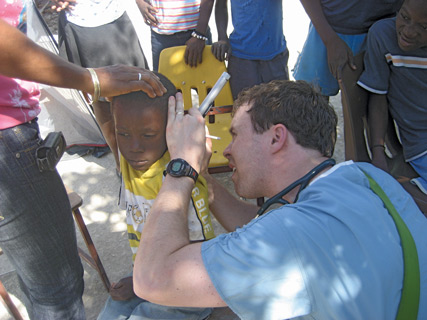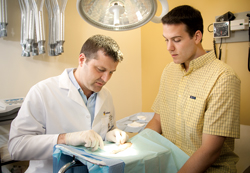MKSAP Quiz: Red eye and pain
A 35-year-old man is evaluated for red eye and acute onset of right eye pain. He wears contact lenses daily. Fluorescein staining is positive for corneal abrasion without a dendritic, or branching, pattern. He is instructed to stop wearing the contact lenses until the abrasion is healed. He calls the next day to report that the pain has worsened, even though he has not worn his contact lenses.
On examination, compared with the previous day's findings, the patient appears to be in more pain, visual acuity of the right eye is worse with Snellen's test, and the abrasion is larger on fluorescein staining. The eye remains red, and there is a mucopurulent discharge.
Which of the following is the most likely diagnosis?
A. Hypopyon
B. Infectious keratitis
C. Herpetic keratitis
D. Anterior uveitis
Answer and Critique
The correct answer is B) Infectious keratitis. This question can be found in MKSAP 14 in the General Internal Medicine section, Item 60.
Corneal abrasion associated with hard or soft contact lenses is especially susceptible to infectious keratitis. The eye is red and painful; vision loss is not usually immediately present, but it may occur as the corneal abrasion progresses or with infectious keratitis. Permanent vision loss may occur. There is an increased risk for fulminant keratitis caused by Pseudomonas sp.
With hypopyon (white or yellowish-white accumulation of purulence in the anterior chamber) and hyphema (blood in the anterior chamber), gravity causes inferior pooling. Both conditions are associated with acute anterior uveitis (red and painful eye with decreased visual acuity) and corneal trauma, infiltrate, or ulcer. Anterior uveitis also presents with red, painful eye, blurred vision, and vision loss, usually in young or middle-aged persons, but is not associated with contact lens use, corneal abrasion, or foreign-body sensation. There is diffuse erythema prominent at the limbus, light reflex is sluggish to unreactive, and the pupil is constricted in patients with anterior uveitis. Diagnosis of this condition usually requires slit-lamp examination, and hypopyon or hyphema may be visible at the base of the anterior chamber. Herpetic keratitis is associated with watery discharge and dendritic, or branching, pattern on fluorescein staining, and may have branching opacities. Hypopyon, infectious keratitis associated with corneal abrasion, and anterior uveitis require emergency referral to an ophthalmologist; viral keratitis should be evaluated by an ophthalmologist in 1 to 2 days.
Key Point
- Corneal abrasion associated with hard or soft contact lenses is especially susceptible to infectious keratitis.





